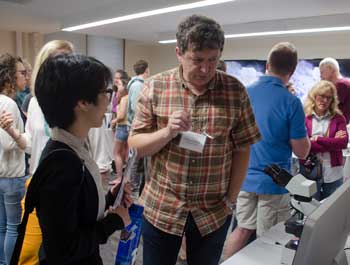Picturing the Invisible: Where Photography and Microscopy Meet

A multitude of bright colors, clean lines filling the canvas, and images with perfect symmetry. A walk through the Nikon Small World Exhibit might have you wondering if you’re in a contemporary art show.
Actually, the images highlight scientific microscopy at the height of creativity and artistry. On July 13, the MBL hosted an event to celebrate the Nikon exhibit’s last day at MBL during its national tour. “Thinking Big by Looking Small” also featured demonstrations by MBL microscopists and a talk by Felice Frankel, a renowned science photographer and research scientist at MIT.
 MBL scientist and microscope developer Michael Shribak explains his innovations to MBL summer science writer Jennifer Tsang in the event's demo room. Credit: Emily Zollo
MBL scientist and microscope developer Michael Shribak explains his innovations to MBL summer science writer Jennifer Tsang in the event's demo room. Credit: Emily ZolloThe history of imaging at MBL covers more than a century and is studded with innovations in both light and electron microscopy.
“Building microscopes and imaging specimens is only half the battle,” said Frankel’s introducer Hari Shroff, an MBL fellow and senior investigator at the National Institute of Biomedical Imaging and Bioengineering. “The other part is how to make sense of the underlying image data and how to convey more meaning with the images we collect.”
Many times, however, there is too much going on in a scientific image and the scientist’s message is lost, Frankel said in her talk. She emphasized simplifying the image and eliminating the “clutter,” so that it becomes more visually striking and communicates more clearly. “Make us look” and “make us understand” are two things a scientific image must do, she said.

Continuing with her theme of simplicity, Frankel showed how she creates images with simple tools. A flatbed scanner, for example, has remarkable resolution: It can delineate individual fibers of paper that are thinner than a human hair.
“All photographs are metaphors. It’s not the [scientific] evidence; it’s showing the evidence,” Frankel said. By carefully choosing what to show and how to show it, the scientist translates the evidence into a visual “re-presentation.”
By simplifying science images, they become more than pretty pictures; they can draw us in and reveal the structure of invisible worlds.